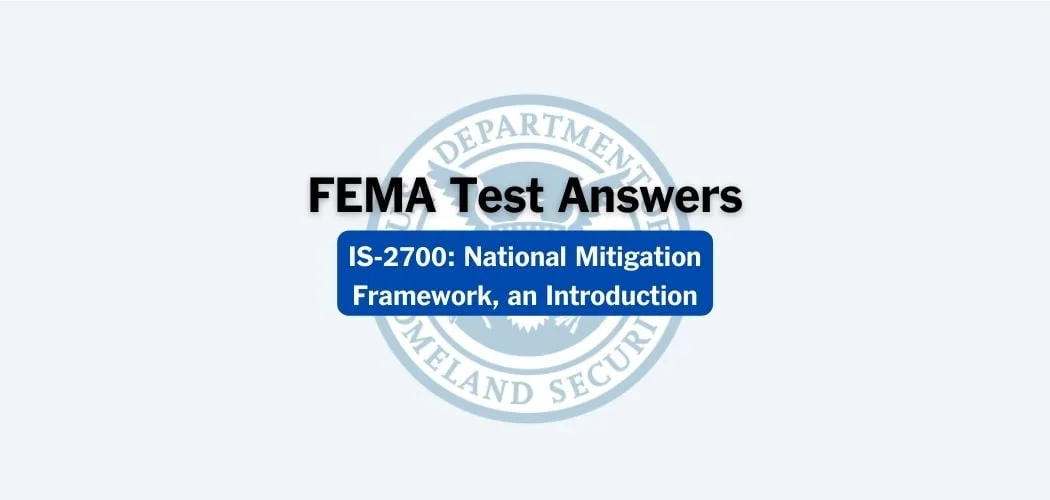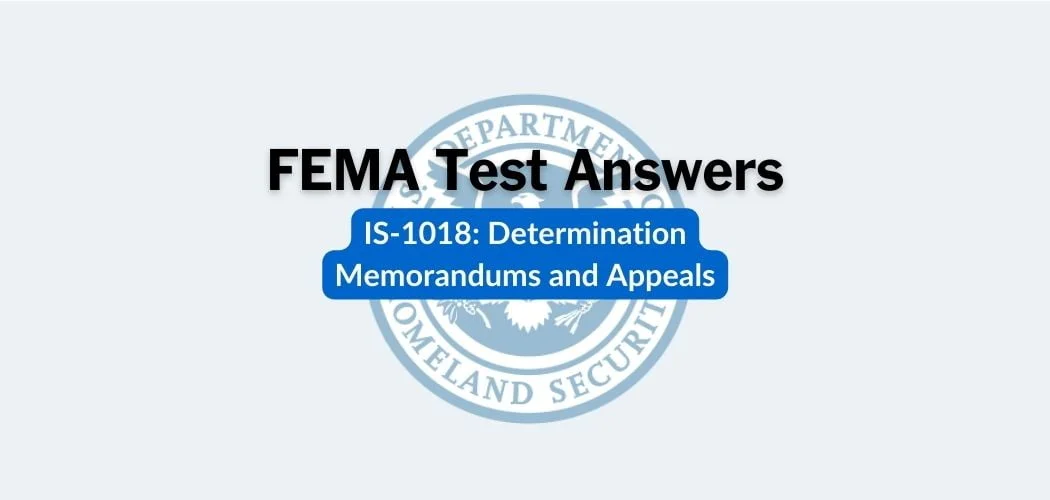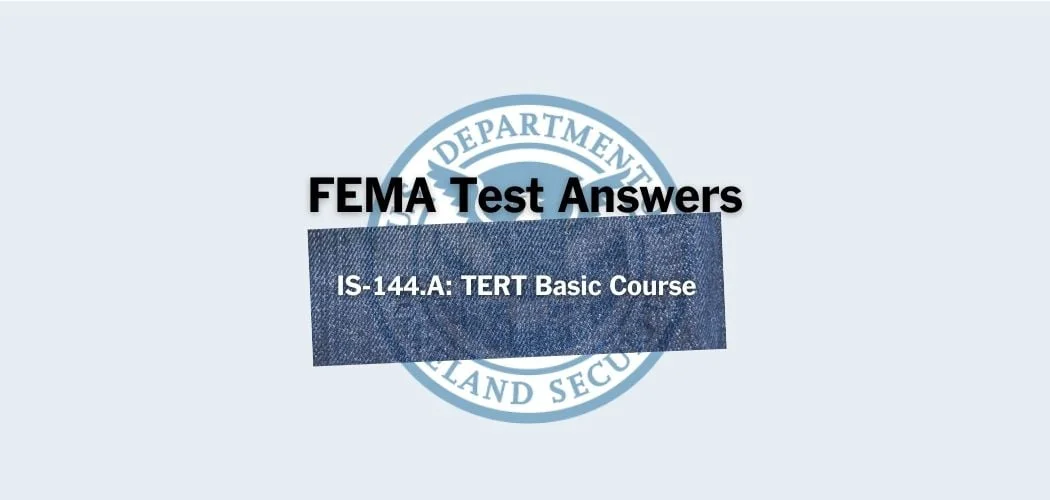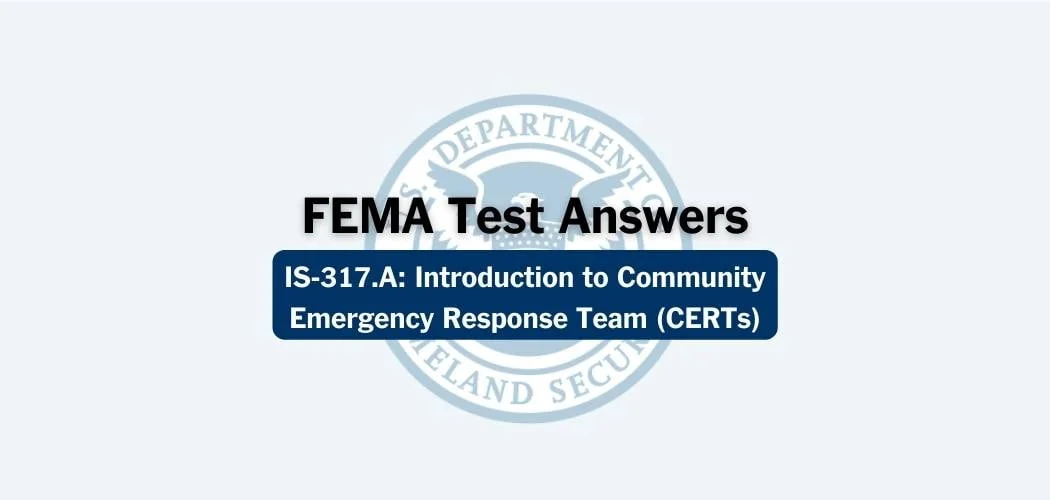Overview: The FEMA IS-1005 course was published on 2/28/2019 to provide an overview of the Public Assistance Alternative Procedures Program. By the end of the course, State, Local, Indian Tribal, and Territorial Applicants and Recipients will be able to understand all aspects of the Public Assistance Alternative Procedures Program.
The goal of the FEMA IS-1005 course is to provide resources and tools to make informed decisions and ensure the Public Assistance Alternative Procedures are properly utilized to enhance disaster recovery.
FEMA IS-1005 test answers
Each time this test is loaded, you will receive a unique set of questions and answers. The test questions are scrambled to protect the integrity of the exam.
Question 1. Each Alternative Procedure has unique requirements and benefits for:
A. FEMA
B. the Applicant✅
C. the Federal government
D. the State
Question 2. Choose the true statement about the 2% increased Federal cost share incentive.
A. The 2% increased Federal cost share incentive may be used along with any other Pilot Program procedure.✅
B. The 2% increased Federal cost share incentive may only be used with one Pilot Program procedure.
C. The 2% increased Federal cost share incentive may only be used along with a Recycling Revenue option.
D. The 2% increased Federal cost share incentive may only be used along with the Accelerated Debris Removal option.
Question 3. FEMA determines if debris removal activities are eligible for Public Assistance funding based on:
A. potential benefit to the public✅
B. how expensive it will be
C. the number of contractors required
D. the amount of staffing needed
Question 4. One of FEMA’s requirements for Applicants to receive a 2% increased Federal cost share incentive is:
A. Applicants must choose a debris removal contractor team within two weeks after the incident
B. Applicants must have a pre-qualified debris removal contractor team✅
C. Applicants must prepare a Debris Management Plan within two weeks after the incident
D. Applicants must put out a bid for a contractor before the Recovery Scoping Meeting
Question 5. Applicants can register for the Pilot Program before the obligation of their first debris removal project or within how many days of their Recovery Scoping Meeting?
A. 30 days
B. 10 days
C. 14 days
D. 60 days✅
Question 6. How does FEMA cap consolidated fixed cost estimate grants?
A. By the amount of ineligible costs for each of the individual grants.
B. At the combined amount of the eligible costs for the formerly separate, individual fixed estimate grants.✅
C. As separate amounts for each individual fixed estimate grant.
D. In separate phases as each project is completed and deemed eligible.
Question 7. Permanent Work under the Alternative Procedures Pilot Program is considered what type of project?
A. Open-ended
B. Capped✅
C. Non-capped
D. Incomplete
Question 8. What was the origin of the Public Assistance Alternative Procedures Pilot Program?
A. Louisiana Improvement Act
B. Hurricane Recovery Act
C. Sandy Recovery Improvement Act✅
D. United States Recovery Act
Question 9. To be eligible for the FEMA-Accepted Debris Management Plan, an Applicant must:
A. prepare a Debris Management Plan prior to the Recovery Scoping Meeting
B. have a FEMA-accepted Debris Management Plan prior to the incident✅
C. prepare a Debris Management Plan within two weeks after the incident
D. prepare a Debris Management Plan after the Recovery Scoping Meeting
Question 10. How many incidents can the 2% increased Federal cost share incentive be used for?
A. Three incidents
B. One incident✅
C. Two incidents
D. Four incidents
Question 11. Under the Alternative Procedures Pilot Program, the Applicant will receive how much of the Alternate Project cost?
A. The full eligible cost✅
B. 75% of the eligible cost
C. 75% of the eligible cost and 25% of the ineligible cost
D. 90% of the eligible cost
Question 12. Choose the true statement about Direct Administrative Costs.
A. Direct Administrative Costs are generally eligible if the Applicant tracks, charges, and accounts for incurred administrative costs directly linked to a specific eligible project.✅
B. FEMA normally considers the salaries of administrative and clerical staff as Direct Administrative Costs.
C. An Applicant can automatically charge costs to a project if it previously allocated similar costs incurred for the same purpose in like circumstances to indirect costs.
D. FEMA provides Public Assistance funding for Direct Administrative Costs at 75% of the cost-share provisions applicable to the declaration.
Question 13. To participate in the Alternative Procedures Pilot Program for Permanent Work, an Applicant must agree to what type of grant?
A. Phased estimate
B. Indeterminate estimate
C. Fixed estimate✅
D. Changeable estimate
Question 14. All of the following are Alternative Procedures for debris removal except:
A. giving away income generated from recycling centers✅
B. increased Federal cost share linked to accelerated completion of debris removal
C. reimbursement of straight-time for force account labor
D. 2% increased cost-share incentive for a FEMA-accepted debris management plan
Question 15. Which type of government creates the laws, regulations, and requirements that affect special considerations for Applicants’ projects?
A. Federal and State
B. Federal and Tribal
C. State and local
D. Federal, State, local, Tribal, and Territorial✅
Question 16. Choose the false statement about the Accelerated Debris Removal Procedure.
A. FEMA is likely to authorize extensions for weather-related delays and inability to obtain permits in a timely manner.✅
B. FEMA increases its cost share above the usual minimum of 75% based on the timeframes shown in the table.
C. FEMA will not provide funding for debris removal activities conducted after 180 days from the start of the incident period unless FEMA grants an extension.
D. The projects must reflect actual costs for all debris removal activities conducted from the incident’s start date until the end of the applicable timeframe.
Question 17. All of the following are goals of the Sandy Recovery Improvement Act of 2013 except:
A. providing decreased assistance to State, local and Tribal governments✅
B. reducing costs to the Federal Government for providing Public Assistance
C. increasing flexibility in the administration of Public Assistance
D. providing financial incentives for timely and cost-effective completion of projects
Question 18. All of the following are objectives of Public Assistance Alternative Procedures for Direct Administrative Costs except:
A. to ensure Applicants provide timely and complete information and documentation to FEMA
B. to reduce the administrative burden on FEMA, the Recipient, and the Applicant
C. to increase administrative duties associated with Public Assistance awards✅
D. to incentivize timely submission of projects for closeout
Question 19. When determining the reasonableness of Direct Administrative Costs, FEMA considers whether the employee’s skill level is appropriate for the activities performed and:
A. why the employee was hired for those specific job duties
B. if the work could have been performed by a pre-qualified contractor
C. whether a portion of the Direct Administrative Cost allowance should be withheld
D. the level of effort required to perform an activity✅
Question 20. For Work Completed, the Applicant must demonstrate compliance with applicable special considerations by providing what?
A. Grants funds
B. Regulations
C. Documentation✅
D. Demolition
Question 21. An example of a special consideration that must be documented is:
A. Choosing a contractor
B. Use of Grants Portal
C. Dumping debris in a landfill✅
D. Staffing requirements
Question 22. The recycling revenue program allows the Applicant to keep revenue received through recycling debris if that revenue is used for an approved purpose and:
A. increases the non-Federal cost share of remaining debris projects
B. is used before the period of performance deadline✅
C. increases the risk of future damage from an incident
D. reduces disaster preparedness and assistance plans
Question 23. The Program Delivery Manager will discuss the Public Assistance Alternative Procedures Pilot Program with Applicants at what meeting?
A. Damage Inventory Meeting
B. Kick-off Meeting
C. Recovery Scoping Meeting✅
D. Program Delivery Plan Meeting
Question 24. What are the two courses of action that Applicants can take when creating a cost estimate?
A. Applicants may request FEMA to develop a cost estimate or request the Recipient to develop a cost estimate.
B. Applicants may create their own cost estimate or request the Recipient to develop a cost estimate.
C. Applicants may create their own cost estimate or request FEMA to develop a cost estimate.✅
D. Applicants may request the Recipient to develop a cost estimate or use an outside vendor to develop a cost estimate.
Question 25. Expenses the Applicant incurs from administering and managing Public Assistance awards that are directly chargeable to a specific project are called:
A. Direct Project Costs
B. Direct Administrative Costs✅
C. Eligible Administrative Costs
D. Public Assistance Grant Costs
Question 26. All of the following are options for the Public Assistance Alternative Procedures Pilot Program for Debris Removal except:
A. reimbursement of Straight-Time for Force Account Labor
B. recycling Revenue✅
C. reduced Debris Removal
D. FEMA-Accepted Debris Management Plan
Question 27. All of the following are special considerations for Alternative Procedures except which one?
A. Insurance
B. Environmental and historic preservation
C. Hazard mitigation
D. Contractors✅
Question 28. Name one of the goals of the Sandy Recovery Improvement Act of 2013.
A. Provide decreased assistance to State, local and Tribal government
B. Expedite the provision of assistance to a State, local or Tribal government✅
C. Increase costs to the Federal Government for providing Public Assistance
D. Decrease flexibility in the administration of Public Assistance
Question 29. Choose the true statement about pre-qualifying contractors.
A. When pre-qualifying contractors, Applicants do not have to comply with Federal procurement requirements.
B. Applicants can choose pre-qualified debris removal contractors after the incident occurs.
C. When pre-qualifying contractors, Applicants must comply with Federal procurement requirements such as competitive bidding.✅
D. A pre-qualified contractor is entitled to a “standby” contract.
Question 30. Choose the false statement about the Consolidation of Multiple Fixed Cost Estimate Grants.
A. An Applicant can decide to use Consolidation of Multiple Fixed Cost Estimate Grants when it combines two or more fixed estimate grants into a single grant.
B. The consolidated grant may be used to restore the pre-disaster condition of all or some of the Applicant’s facilities.
C. An Applicant may consolidate grants from different Categories of Work (Category C-G) or consolidate within the same Category of Work.
D. Consolidation of Multiple Fixed Cost Estimate Grants provides less flexibility to Applicants in completing their projects.✅
Question 31. Choose the true statement about Public Assistance Alternative Procedures.
A. An Applicant may choose to apply Alternative Procedures to certain facilities and choose to have other work funded under Public Assistance standard procedures.✅
B. To participate in the Pilot Program for Permanent Work, an Applicant must agree to an undetermined grant.
C. FEMA does not require the fixed estimate grant feature to gain access to other optional alternative procedures.
D. An Applicant must use all of the features of the Pilot Program for Permanent Work on a project with the approval of FEMA.
Question 32. Under the Alternative Procedures Pilot Program for Permanent Work, the Applicant is granted ______ flexibility in repairing and rebuilding eligible facilities.
A. less
B. complete
C. minimal
D. more✅



